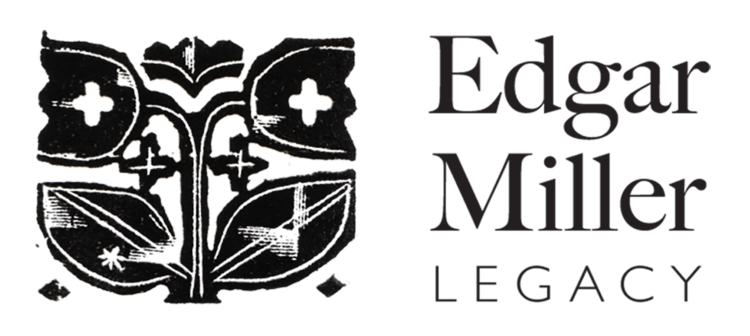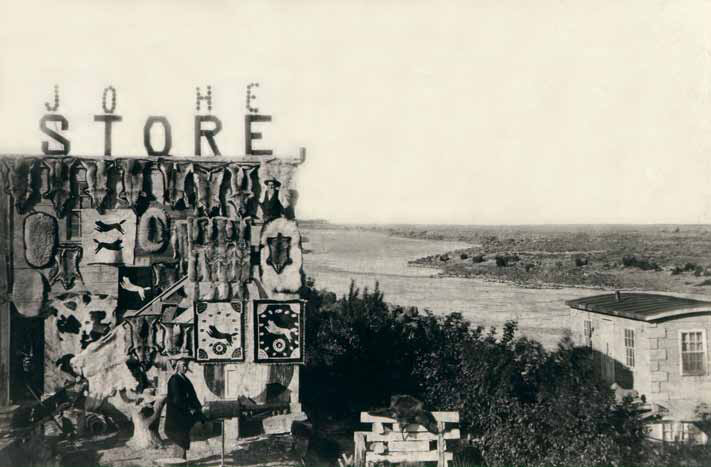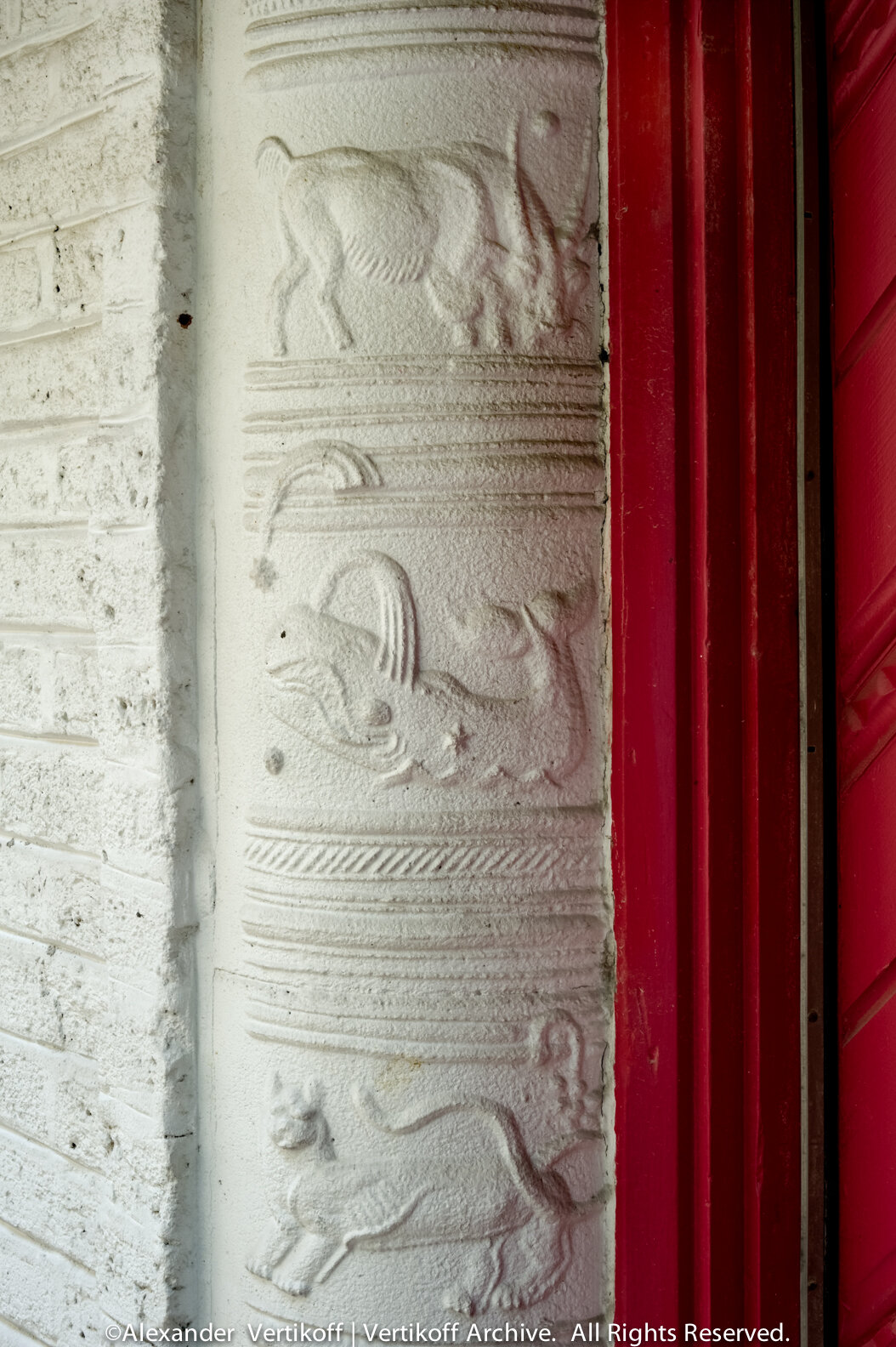Edgar Miller’s Influences:
Jo He
Jo He Store, situated along the Snake River, on the outskirts of Idaho Falls, Idaho, circa 1900.
Edgar Miller’s early career is full of tales of different influences and mentors that helped to shape the artist into the successful “Renaissance Man” of the twentieth century we know and appreciate to this day. Even in boyhood, Miller was a well-traveled, open-minded creative character who was eager to learn about all the beautiful aspects of the world around him. Growing up in the small frontier town of Idaho Falls, Idaho around the turn of the twentieth century, the spirit of exploration and discovery was very much in his blood. As the second eldest of a close-knit family, Edgar was often encouraged to take the lead, learn from his surroundings, and even make mistakes; and while his parents encouraged his free spirit, natural talents, and proclivity towards artistic craftsmanship, Miller was only able to teach himself so much without turning to others for help. Throughout his life, Miller always sought out mentors and those with a similar free spirit who allowed him to learn through methods most conducive to his abilities, such as observation, collaboration, and experimentation.
The Story of Jo He
One of his earliest and really most revered mentors was a man Edgar met when he was only a young boy. Ozro French Eastman, who later in life when Edgar met him went by the self-appointed name Jo He, was born in 1828 to James and Clarissa Goss Eastman. His parents became Mormons in the religion’s earliest days in Nauvoo, Illinois, before the community was exiled from the Midwest. Eastman and his family would have been present at the martyrdom of Joseph Smith, and despite the chaotic period followed his family across the country in a journey without a clear endpoint. The Eastmans made the trek with Mormon leader Brigham Young and 148 other pioneers first to Winter Quarters, Nebraska. Several of the settlers who made it there, including James Eastman, succumbed to illness. Before passing away, Ozro’s father secured for his son a membership in Brigham Young’s Vanguard Company in 1847, which allowed Ozro to travel west towards the Great Salt Lake. Ozro, still a teenager at the time, was considered old enough to make his own choices as to whether to convert to the Church of Latter-day Saints. Perhaps due to the years of observing the persecution and hardship the early Mormons endured, or perhaps because of his fierce independent spirit, Ozro was never himself baptized into the church.
Ozro married his wife Mary Whittle in 1857, where he worked as the proprietor of the purported first harness shop in Salt Lake City, and he fathered ten children. In 1884, the Eastmans moved to Idaho Falls (then called Eagle Rock), and set up a homestead and handmade goods store on the outskirts of the southside of town along the Snake River. By the late 1890s, Ozro and Mary had transformed his goods store to an artisanal emporium, and he was going by the name Jo He. Edgar would later explain, “He called himself a ‘He,’ or a man named ‘Jo,’ which for him stated his generalized human identity before God.”
Edgar Miller (center) and Frank Miller (right) with a friend on Crow Creek.
The Crazy Old Coot Outside of Town
Jo He was one of the first people Edgar’s father, James Miller, met when he first arrived in Eagle Rock. Jo He was found on the train station platform selling rattlesnake oil liniment—“good for aches and sprains, rheumatism and dislocations”—and James immediately was drawn in by the old man’s independent nature. Edgar would remark later in his life that his father was one of the few people in town who didn’t call Jo He “that crazy old coot”. “In the eyes of Eagle Rock, he was crazy because everything he did was original.” The townspeople circulated many folktales about the Eastmans, as was often the habit when dealing with those who preferred a more secluded life. They questioned whether Mary was a witch, for instance, and gossiped that Jo He was a vengeful Mormon angel. Most children were taught to keep their distance.
As a young boy, however, Edgar, and later his younger brother Frank and sister Hester, were allowed to visit the Eastman residence, and were welcomed inside by the highly creative master. Climbing up the bluff facing towards the storefront, Edgar would have first noticed the metal letters that sat on the store roof, “JO HE STORE”, with the “JO” and the “HE” made of ruby bridle mirrors that would catch the sunlight, like a pre-electricity neon sign. Approaching the site, Edgar would have seen the series of one-story brick and stone blocks that made up the shop, the lowest story standing on stilts above a sixty-foot bluff overlooking the riverbanks. Behind a fence of shining tin cans at the end of the sagebrush south of town, in front of the shop was a giant sandstone sculpture of an eagle capturing a screeching rattlesnake. Like many frontiersmen from the eastern states, Jo He was enamored by the art and craftwork produced by the indigenous people that he came across, traded with, and came to know as compatriots in artisanship. The store was covered with samples of rugs, tanned hides, and leather-goods, all hand-decorated with simple shapes and intricate animal patterns, many of which took inspiration from local Native American tribal motifs. Many of these early patterns, motifs symbolizing elemental features like water, plants, animal tracks, and rocks, would often be subtly incorporated into Miller’s own future artwork.
Above: Photograph of Jo He (Ozro Eastman) with accoutrement from his shop including animal hides, woven rugs, sculptures, paintings, and many other crafted goods, c. 1910. Below: Jo He’s influence inspired Edgar Miller to always find ways to surprise and delight with creative flourishes, such as these bas relief sculptures at the Frank Fisher Studios (1936). Photo © Alexander Vertikoff.
Edgar would later go on to describe Eastman in his writings: “He called himself a He, or a man named Jo, which for him stated his generalized human identity before God…He was a bearded patriarch who looked very much like Walt Whitman in his old age…He carved stone, built his own home, was a tanner, a taxidermist, imaginative gardener, inventor, mural painter, saddle maker and sheet metal worker.” Just as fascinating to a schoolboy as the eccentric recluse were the intricately tooled homegoods, craftwork, and appliances that filled the store. Jo He’s workshop was home to a number of projects in various stages of completion, from fancy saddles to a landscape painting to highly creative taxidermy depicting animals in moments of high drama. It should be noted that later in Miller’s life when visitors came to his studio, they were welcomed to a very similar workshop-like experience.
Jo He helped Miller explore his innate knack for craftsmanship, and growing sense of tactile expression, by translating the things that Edgar saw around him into art. Edgar would spend days wandering the wilderness stumbling upon hot spring watering holes and searching for arrowheads in the dirt. An assortment of both wild animals and beautiful plant-life helped fuel a love for nature that would be expressed in Edgar’s art for the rest of his career. As in Jo He’s work, there was a romanticism to the observable features of the land that directly inspired the Millers. Miller wrote, “His example said one thing to me, ‘If you want to do anything, go ahead and do it.’ All I had to do was try. From that time on, I have tried to be creative in every act, for without the surrounding of small art, there can never be a development of great art… It is difficult to convey the lusty enthusiasm that attended all of Jo He’s work, and gave me understanding of emotional tones and dramatic approaches to work. It is a kind of love for what one is doing, that one never outgrows. Age does not dim this enthusiasm.”
Carved Bakelite bracelet made for Miller’s second wife Dale Holcomb in 1933, the year they first met. The piece showcases many of the same animal forms and plant structures that he played with in Idaho. Photo © Alexander Vertikoff.
Edgar Miller’s Youth and Earliest Creative Pursuits
Never one to settle down for too long, Edgar’s father decided the family should move to Australia, in 1913. Edgar and his brother Frank were the first to journey alongside their father, out from California by ocean liner for a two-year stint that ultimately proved to be unfruitful for the family (Edgar’s mother and three other siblings remained in Idaho Falls, and never came to Australia). As the farm that Miller’s father started in 1914 in the outback near Maldon failed, Edgar received a scholarship to attend the School of Mines in Ballarat to study art and design, but quickly became bored with the uninspiring instruction, so dropped out and found a job doing commercial work for Tulloch and King Lithographers. Upon finally returning home to Idaho Falls at the age of 15, Miller spent his last year or so back with his whole family and attending the local high school. School had never been Edgar’s strong suit, not because of his inability to learn, but because his reading, math, and apprehension skills were so much more advanced than those of his schoolmates. His brother Frank recollected about Edgar that, “My brother’s difficulties in school were caused by his photographic memory, and creative ability. We had long accepted the fact that he was different, and it was not a problem in the family. In school, however, it caused great annoyance to the students and teacher alike. He would read his books at the beginning of the term, and spend the rest of his time in class drawing.” Miller, always searching for a creative outlet, produced beautiful illustrations for local commissions including his high school yearbooks.
Images of illustrations by Edgar Miller from his grade school and high school years, including a piece he was commissioned to make for his high school year book. From an early age Miller started to sketch and play with graphics nearly every day of his life, c. 1914.
Jo He was a regular fixture in Miller’s life throughout his childhood. Throughout that time, the Miller children, with Edgar being more independent-minded and a natural ring-leader, all grew to appreciate the inventiveness that Jo He would help cultivate and inspire among the young artists. All three Miller children eventually would, years later, come to Chicago to carry on careers as artists and artisans in a new setting. Edgar would be the first Miller sibling to leave for the Midwest, when he was accepted to the School of the Art institute of Chicago, in 1917. Before leaving Idaho Falls, he went back one last time to visit Jo He’s workshop. Jo He had passed away at the age of eighty-seven the year before, and left his workshop and store abandoned. The site quickly had quickly become overrun, much to the disappointment of Edgar.
Richard Cahan writes of that moment in Edgar Miller and the Handmade Home, “The scene saddened Edgar, who sought out one last piece of inspiration at the local cemetery. Eastman had carved a tombstone for a young girl—a ladder extending to a partly opened door to heaven—that Edgar thought stood out from all the proper grave markers, which competed by quality and weight of stone, as the cemetery’s only human statement of love.” This was Edgar’s goodbye to Jo He and an end to a wonderful childhood, whose openness to exploration and inspiration was carried along by Edgar throughout the rest of his life.






